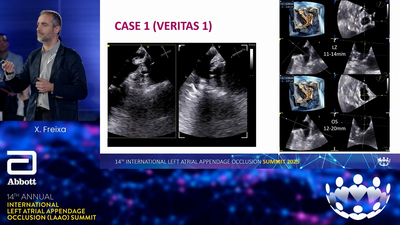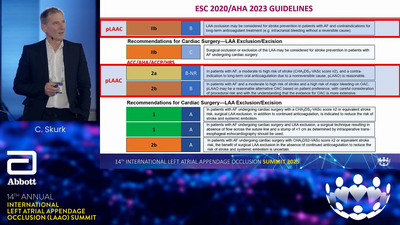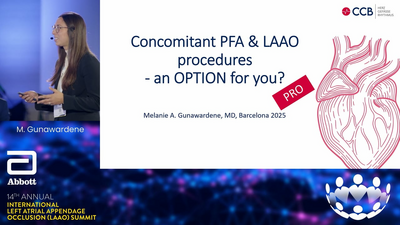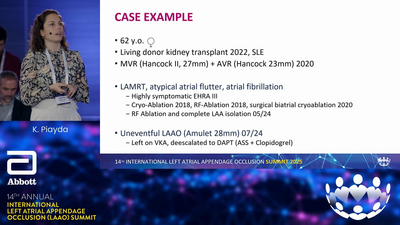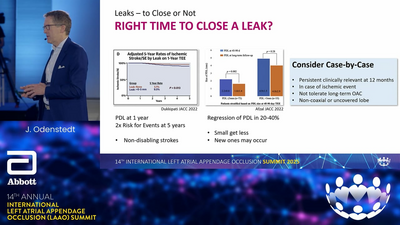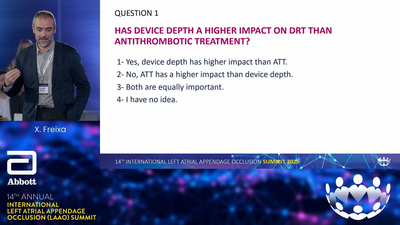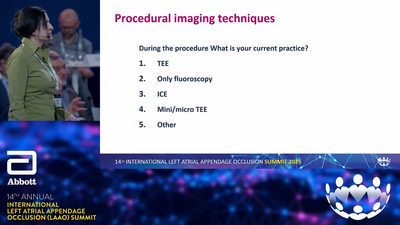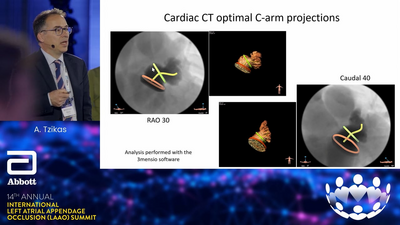STROKE RISK FACTORS
Atrial fibrillation (AF) is associated with a 5-fold increase in the risk of ischemic stroke.1 Left atrial appendage (LAA) closure reduces the risk of stroke in non-valvular AF patients (NVAF) who are seeking an alternative to oral anticoagulants.2,3
SWITCH TO THE interventional VIEW For more information specific to interventional cardiology regarding LAA Occlusion
Life-long medication to reduce stroke risk is not an option for many patients. The Amplatzer™ Amulet™ LAA Occluder permanently closes this primary stroke pathway without requiring these patients to endure the challenges of OACs. The Amulet™ Occluder can be a good option1–5 for patients who:
For patients with poorly controlled or uncontrolled hypertension, oral anticoagulants are contraindicated. Amplatzer Amulet occluder is an alternative to life-long oral anticoagulants that are not a safe choice for these patients.

Regina* (AGE 55)
Regina, who has NVAF and a CHA2DS2-VASc score is 4, has had poorly controlled hypertension for 10 years. Her doctor wants to reduce her stroke risk without jeopardizing her safety.
NVAF patients with poorly controlled hypertension should know that there is an alternative.
The long-term bleeding risks associated with OACs such as warfarin are particularly concerning for patients with active lifestyles or occupations. Consider Amplatzer Amulet occluder for active patients.

Rita* (AGE 65)
Rita has NVAF and a CHA2DS2-VASc score of 4. She is reducing her stroke risk without having to limit her travel and play with her grandchildren.
NVAF patients who want to remain active should know that there is an alternative.
A fall can erode a patient’s confidence and willingness to engage in everyday tasks. It can also lead to a major bleeding event. Consider Amplatzer Amulet occluder when you or your patients are concerned about the risk of falls or bleeding.

Nathan* (AGE 80)
Nathan, who has NVAF and a CHA2DS2-VASc score of 5, hit his head the last time he fell. He and his doctor want to reduce his stroke risk without increasing his risk for a major bleeding event.
NVAF patients at high risk for bleeding should know that there is an alternative.
OACs are incompatible with treatments for many comorbidities including depression or arthritis. Amplatzer Amulet occluder is an alternative to oral anticoagulants that can increase the risk of drug interactions.

Michael* (AGE 75)
Michael has Non-Valvular Atrial Fibrillation (NVAF) and a CHA2DS2-VASc score of 5. He is reducing his stroke risk without increasing his risk for drug interactions.
NVAF patients with comorbidities should know that there is an alternative.
Adverse effects, the cost of Novel Oral Anticoagulants (NOACs), or the monitoring required when taking warfarin, often make compliance a challenge for patients. Amplatzer Amulet occluder is an alternative to life-long oral anticoagulants that can lead to noncompliance.

Sarah* (AGE 73)
Sarah has NVAF and a CHA2DS2-VASc score of 4. She is reducing her stroke risk without having to take OACs for the rest of her life.
NVAF patients who struggle with compliance should know that there is an alternative.

CONTRAINDICTION
TO OACs
For patients with poorly controlled or uncontrolled hypertension, oral anticoagulants are contraindicated. Amplatzer Amulet occluder is an alternative to life-long oral anticoagulants that are not a safe choice for these patients.

Regina* (AGE 55)
Regina, who has NVAF and a CHA2DS2-VASc score is 4, has had poorly controlled hypertension for 10 years. Her doctor wants to reduce her stroke risk without jeopardizing her safety.
NVAF patients with poorly controlled hypertension should know that there is an alternative.

HAVE HAD
A
BLEEDING EVENT
The long-term bleeding risks associated with OACs such as warfarin are particularly concerning for patients with active lifestyles or occupations. Consider Amplatzer Amulet occluder for active patients.

Rita* (AGE 65)
Rita has NVAF and a CHA2DS2-VASc score of 4. She is reducing her stroke risk without having to limit her travel and play with her grandchildren.
NVAF patients who want to remain active should know that there is an alternative.

ARE AT
HIGH
RISK FOR FALLS
A fall can erode a patient’s confidence and willingness to engage in everyday tasks. It can also lead to a major bleeding event. Consider Amplatzer Amulet occluder when you or your patients are concerned about the risk of falls or bleeding.

Nathan* (AGE 80)
Nathan, who has NVAF and a CHA2DS2-VASc score of 5, hit his head the last time he fell. He and his doctor want to reduce his stroke risk without increasing his risk for a major bleeding event.
NVAF patients at high risk for bleeding should know that there is an alternative.

ARE AT RISK
FOR
DRUG INTERACTIONS
OACs are incompatible with treatments for many comorbidities including depression or arthritis. Amplatzer Amulet occluder is an alternative to oral anticoagulants that can increase the risk of drug interactions.

Michael* (AGE 75)
Michael has Non-Valvular Atrial Fibrillation (NVAF) and a CHA2DS2-VASc score of 5. He is reducing his stroke risk without increasing his risk for drug interactions.
NVAF patients with comorbidities should know that there is an alternative.

ARE NOT ADHERING TO ROUTINE MONITORING
Adverse effects, the cost of Novel Oral Anticoagulants (NOACs), or the monitoring required when taking warfarin, often make compliance a challenge for patients. Amplatzer Amulet occluder is an alternative to life-long oral anticoagulants that can lead to noncompliance.

Sarah* (AGE 73)
Sarah has NVAF and a CHA2DS2-VASc score of 4. She is reducing her stroke risk without having to take OACs for the rest of her life.
NVAF patients who struggle with compliance should know that there is an alternative.
†CHA2DS2VASc SCORE TOOL6
| CONDITION | POINTS | |
|---|---|---|
| C | Congestive heart failure | 1 |
| H | Hypertension | 1 |
| A2 | Age ≥ 75 years | 2 |
| D | Diabetes mellitus | 1 |
| S2 | Stroke/TIA | 2 |
| V | Vascular disease | 1 |
| A | Age 65–74 years | 1 |
| Sc | Sex category (female) | 1 |
CONFIDENCE WITH LAA OCCLUSION
“The confidence it gave me, knowing that they didn’t have to thin the blood down, and the chance of having a blood clot was diminished by over 90%. It was just mind blowing. I felt I’ve won the lottery.”
Derek, Worthing, England
TV
TV
- Amplatzer™ Amulet™ LAA Occluder Instructions for Use.
- Lakkireddy D, Thaler D, Ellis CR, et al. Amplatzer Amulet Left Atrial Appendage Occluder versus Watchman device for stroke prophylaxis (Amulet IDE): A randomized controlled trial. Circulation. 2021; 144(19):1543–1552. doi.org/10.1161/CIRCULATIONAHA.121.057063.
- Suradi HS, Hijazi ZM. Left atrial appendage closure: outcomes and challenges. Neth Heart J. 2017;25(2):143–151. doi.org/10.1007/s12471-016-0929-0.
- Kakkar AK, Mueller I, Bassand JP, et al. Risk profiles and antithrombotic treatment of patients newly diagnosed with atrial fibrillation at risk of stroke: perspectives from the international, observational, prospective GARFIELD registry. PLOS ONE. 2013;8(5):e63479. doi.org/10.1371/journal.pone.0063479.
- Baman JR, Mansour M, Heist EK, et al. Percutaneous left atrial appendage occlusion in the prevention of stroke in atrial fibrillation: a systematic review. Heart Fail Rev. 2018;23(2):191–208. doi.org/10.1007/s10741-018-9681-4.
- European Heart Rhythm Association; European Association for Cardio-Thoracic Surgery; Camm AJ, Kirchhof P, Lip GY, et al. Guidelines for the management of atrial fibrillation: the Task Force for the Management of Atrial Fibrillation of the European Society of Cardiology (ESC). Eur Heart J. 2010;31(19):2369–429. doi.org/10.1093/eurheartj/ehq278. Erratum in: Eur Heart J. 2011;32(9):1172. PMID: 20802247.
